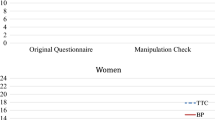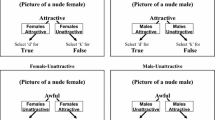Abstract
Five groups of males were compared on penile volume changes elicited from viewing short movie strips and slides of nude children and adults of both genders. Subject groups were sex offenders against adult females, volunteer controls who erotically preferred adult females, volunteer controls who erotically preferred adult males, heterosexual pedophiles, and homosexual pedophiles. Pedophiles differentiated erotically between females and males less than males who erotically preferred physically mature partners.
Similar content being viewed by others
References
Abel, G. G., Becker, J. V., Murphy, W. D., and Flanagan, B. (1981). Identifying dangerous child molesters. In Stuart, R. B. (ed.),Violent Behavior: Social Learning Approaches to Prediction, Management and Treatment Brunner/Mazel, New York, pp. 116–137.
Bancroft, J. H. J., Jones, H. G., and Pullen, B. R. (1966). A simple transducer for measuring penile erection, with comments on its use in the treatment of sexual disorders.Behav. Res. Ther. 4: 239–241.
Finkelhor, D. (1984).Child Sexual Abuse: New Theory and Research Free Press, New York.
Freund, K. (1961). A laboratory differential diagnosis of homo and heterosexuality—An experiment with faking.Rev. Czechoslovak Med. 7: 20–31.
Freund, K. (1963). A laboratory method for diagnosing predominance of homo- or heteroerotic interest in the male.Behav. Res. Ther. 1: 85–93.
Freund, K. (1967a). Diagnosing homo- and heterosexuality and erotic age-preference by means of a psychophysiological test.Behav. Res. Ther. 5: 209–228.
Freund, K. (1967b). Erotic preference in pedophilia.Behav. Res. Ther. 5: 339–348.
Freund, K., and Blanchard, R. (1986). The concept of courtship disorder.J. Sex Marital Ther. 12: 79–92.
Freund, K., and Blanchard, R. (1989). Phallometric diagnosis of pedophilia.J. Consult. Clin. Psychol. 57: 1–6.
Freund, K., Chan, S., and Coulthard, R. (1979). Phallometric diagnosis with “Nonadmitters”.Behav. Res. Ther. 17: 451–457.
Freund, K., Diamant, J., and Pinkava, V. (1958). On the validity and reliability of the phalloplethysmographic diagnosis of some sexual deviations.Rev. Czechoslovak Med. 4: 145–151.
Freund, K., Watson, R., and Dickey, R. (1990). Is there support for the notion that sexual abuse in childhood causes pedophilia: An exploratory study.Arch. Sex. Behav. 19: 557–568.
Freund, K., Watson, R., and Rienzo, D. (1987). A comparison of sex offenders against female and male minors.J. Sex Marital Ther. 13: 257–260.
Freund, K., Watson, R., and Rienzo, D. (1988). Signs of feigning in the phallometric test.Behav. Res. Ther. 26: 105–112.
Gebhard, P. H., Gagnon, J. H., Pomeroy, W. B., and Christenson, C. V. (1965).Sex Offenders: An Analysis of Types Harper & Row, New York.
Hindman, J. (1988). Research disputes assumptions about child molesters.NDAA Bull. 7: 1–3.
Hollingshead, A. B., and Redlich, F. C. (1958).Social Class and Mental Illness: A Community Study John Wiley, New York.
Langevin, R., Wortzman, G., Wright, P., and Handy, L. (1989). Studies of brain damage and dysfunction in sex offenders.Ann. Sex Res. 2: 163–179.
Langevin, R., Wright, P., and Handy, L. (1989). Characteristics of sex offenders who were sexually victimized as children.Ann. Sex Res. 2: 227–253.
Marshall, W. L., Barbaree, H. E, and Christophe, D. (1986). Sexual offenders against female children: Sexual preferences for age of victims and type of behavior.Can. J. Behav. Sci. 18: 424–439.
McConaghy, N. (1989). Validation by penile volume assessment of self-report of sexual orientation: Distributed dimensionally. Manuscript submitted for publication.
Mohr, J. W., Turner, R. E., and Jerry, M. B. (1964).Pedophilia and Exhibitionism University of Toronto Press, Toronto.
Quinsey, V. L., Chaplin, T. C., and Carrigan, W. F. (1979). Sexual preferences among incestuous and nonincestuous child molesters.Behav. Ther. 10: 562–565.
Author information
Authors and Affiliations
Additional information
This research supported in part by Grant No. MA-9134 from the Medical Research Council of Canada.
Rights and permissions
About this article
Cite this article
Freund, K., Watson, R., Dickey, R. et al. Erotic gender differentiation in pedophilia. Arch Sex Behav 20, 555–566 (1991). https://doi.org/10.1007/BF01550954
Issue Date:
DOI: https://doi.org/10.1007/BF01550954




